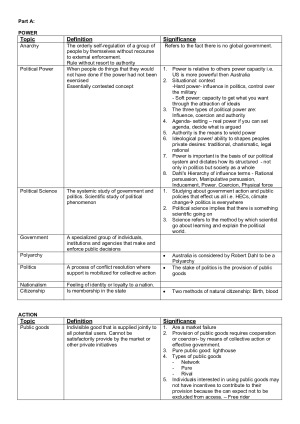POLS1002 Exam Prep Notes
Subject notes for ANU POLS1002
Description
Each topic has definition and details of significance Topics: - Anarchy - Political Power : hard/ soft power, influence coercion and authority - Political Science - Government - Polyarchy - Politics - Nationalism - Citizenship : birth and blood - Public goods: demand and supply, market failure - Pure public goods, Rival public goods, Network public goods, Club goods, common goods, Private goods - free rider, tragedy of commons - collective action: size of group, common interest, trust, R=BxP-C+D - voice, loyalty, exit - game theory, Stag hunt, chicken, prisoners dilemma, nash equilibrium, - community, empire - multi level governance, multinational state - The state - sovereignty: Australia's division, popular, parliamentary - Bicameralism - Dictatorship, Totalitarianism, Democracy - Rule of Law - International order - Parties: Cadre, Exogenous, Endogenous, Activist, Firm, Mass, Militant, Political _ Convergence, incumbant advantage - median voter, voters curve of preference and indifference - Dispersion and Dominance criterion - Absolute majority, A majority runoff, Pareto criterion, Relative majority, Simple majority, Qualified majority, Micro-mega rule, Proportional representation - division of powers: Constitution, Confederal arrangement, Separation of powers 1. Legislative- makes the general laws of the land 2. Executive- proposes politics 3. Judicial- resolve conflicts - Electoral college, Judicial independency COMPARE AND CONTRAST - Details of each topic and similarities and differences 1. Democracy and Dictatorships 2. State and Nation 3. Unitary, Federal and Co-Federal 4 Advantages and disadvantages of Federalism 5. Presidential, Parliamentary, Semi-Presidential 6. Cabinet in Parliamentary, Presidential and Semi-Presidential 7. Premier- Presidential and Presidential - Parliamentary 8. Majority rule and proportional representation 9 Judicial influence: Australia vs America
ANU
Semester 1, 2017
14 pages
5,655 words
$29.00
2
Campus
ANU, Acton
Member since
February 2017
